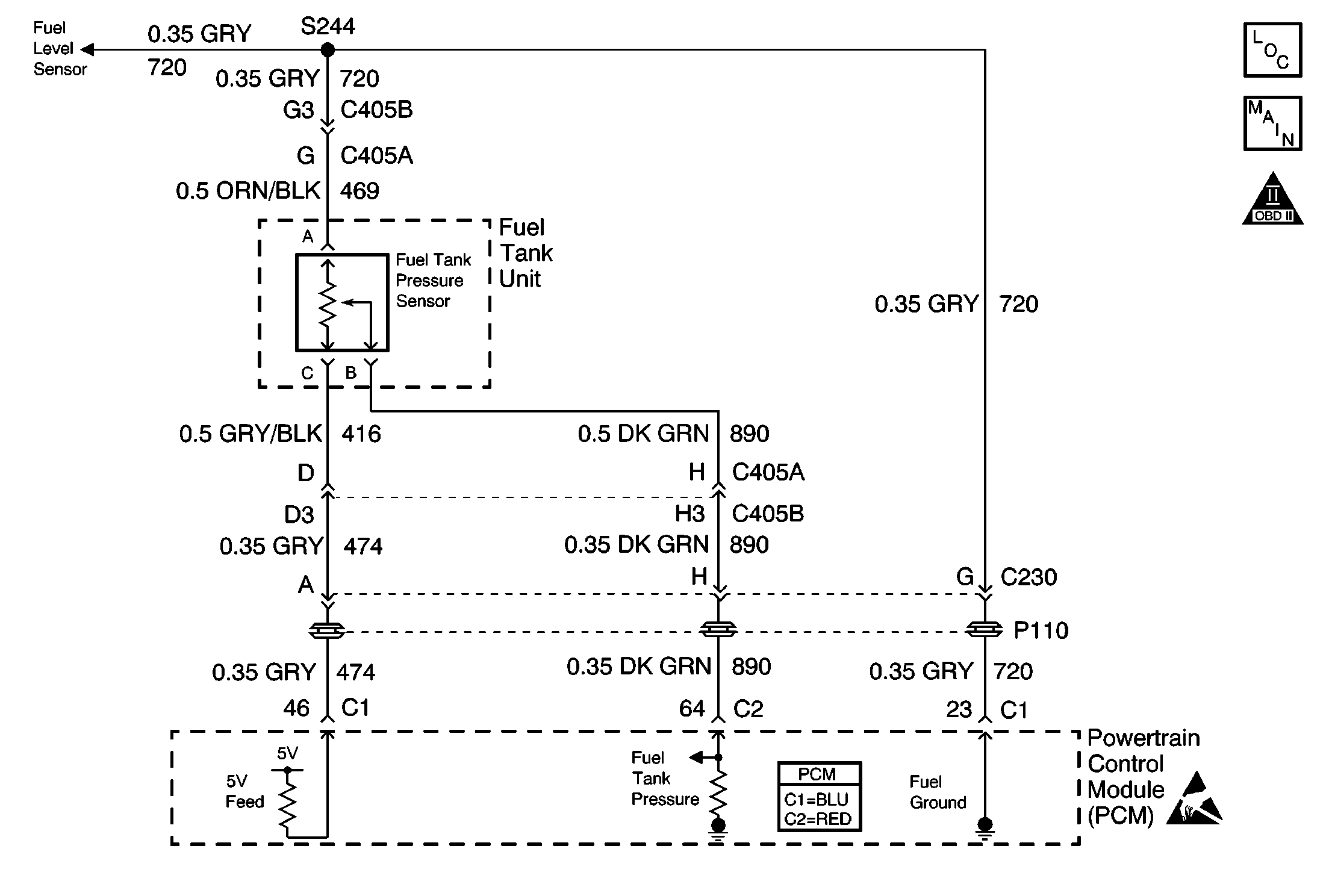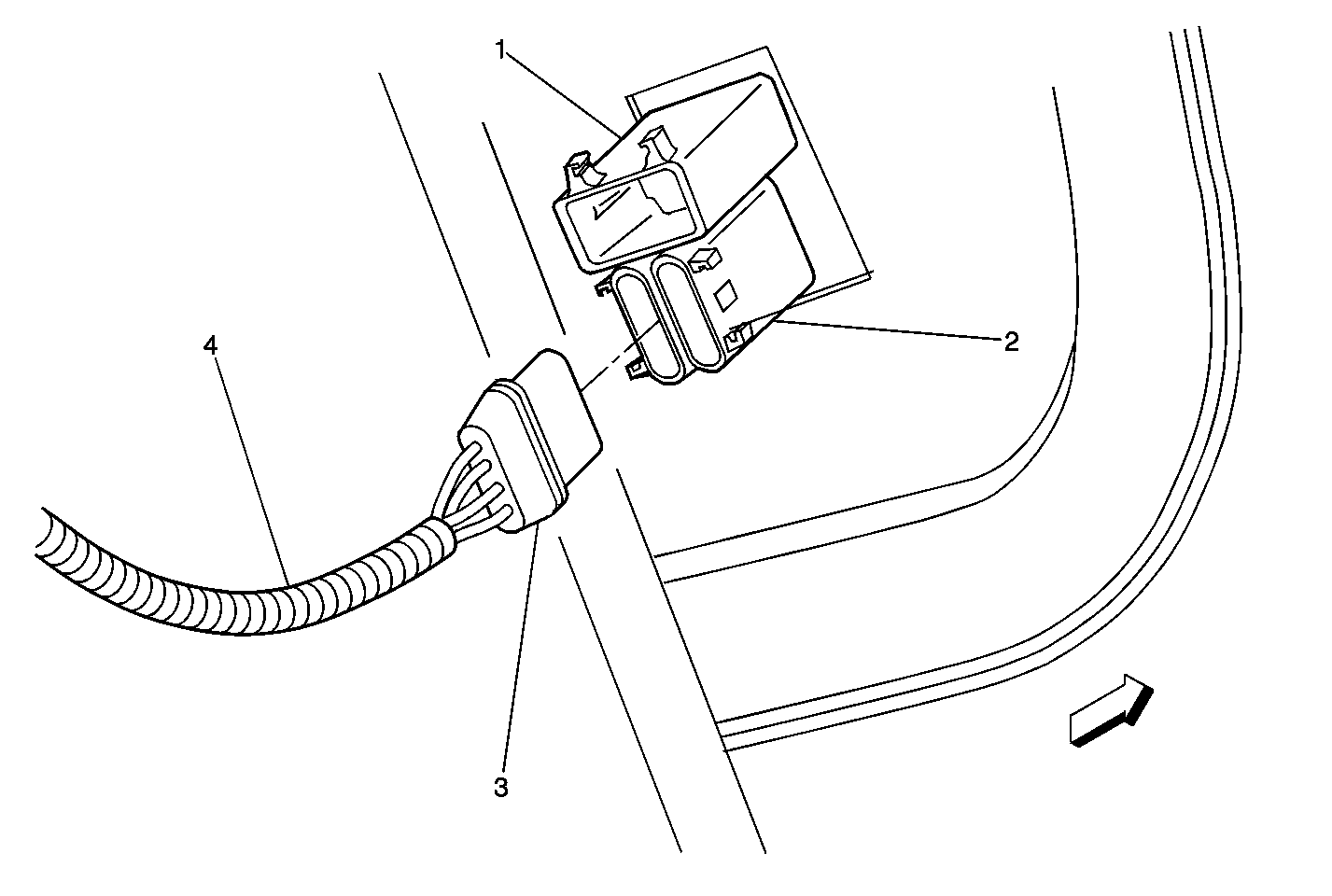
Circuit Description
The Fuel Tank Pressure sensor changes resistance values based on the fuel tank pressure (or vacuum). A vacuum is considered negative pressure.
The PCM provides a 5.0 volt reference and a ground. The Fuel Tank Pressure sensor signal varies between ground and 5.0 volts as fuel tank pressure varies. The Fuel Tank Pressure sensor voltage increases as the fuel tank pressure decreases (negative pressure, or vacuum). The Fuel Tank Pressure sensor voltage decreases (positive pressure, low voltage) as the fuel tank pressure increases. The PCM uses the Fuel Tank Pressure sensor voltage for EVAP system leak detection. This DTC sets when the Fuel Tank Pressure sensor signal goes above a predetermined value.
Conditions for Setting the DTC
The ignition switch is in the RUN position.
Conditions for Setting the DTC
| • | The Fuel Tank Pressure sensor voltage is more than 4.90 volts. |
| • | All conditions present for more than 5 seconds. |
Action Taken When the DTC Sets
| • | The PCM illuminates the malfunction indicator lamp (MIL) on the second consecutive ignition cycle that the diagnostic runs and fails. |
| • | The PCM records the operating conditions at the time the diagnostic fails. The first time the diagnostic fails, the PCM stores this information in the Failure Records. If the diagnostic reports a failure on the second consecutive ignition cycle, the PCM records the operating conditions at the time of the failure. The PCM writes the conditions to the Freeze Frame and updates the Failure Records. |
Conditions for Clearing the MIL/DTC
| • | The PCM turns OFF the malfunction indicator lamp (MIL) after 3 consecutive ignition cycles that the diagnostic runs and does not fail. |
| • | A last test failed, or current DTC, clears when the diagnostic runs and does not fail. |
| • | A history DTC clears after 40 consecutive warm-up cycles, if no failures are reported by this or any other emission related diagnostic. |
| • | Use a scan tool in order to clear the MIL and the DTC. |
Diagnostic Aids
Important:
• Remove any debris from the PCM connector surfaces before servicing
the PCM. Inspect the PCM connector gaskets when diagnosing/replacing the PCM.
Ensure that the gaskets are installed correctly. The gaskets prevent
water intrusion into the PCM. • For any test that requires probing the PCM or a component
harness connector, use theJ 35616
connector test adapter kit. Using this kit prevents damage to
the harness/component terminals. Refer to
Using Connector Test Adapters
in Wiring Systems.
An open Fuel Tank Pressure sensor ground circuit will not set this DTC. A Fuel Tank Pressure sensor that does not respond to pressure changes may indicate a circuit condition.
The Fuel Tank Pressure Sensor range is from 7.5 in. H2O of pressure to -17.5 in. H2O of pressure (vacuum).
Using Freeze Frame and/or Failure Records data may aid in locating an intermittent condition. If you cannot duplicate the DTC, the information included in the Freeze Frame and/or Failure Records data can aid in determining how many miles since the DTC set. The Fail Counter and Pass Counter can also aid determining how many ignition cycles the diagnostic reported a pass and/or a fail. Operate the vehicle within the same freeze frame conditions (RPM, load, vehicle speed, temperature etc.) that you observed. This will isolate when the DTC failed.
For an intermittent, refer to Symptoms .
The vacuum and pressure in the EVAP system is measured in inches of H2O (water). Most gauges measure vacuum in inches of Hg (mercury) and pressure in psi (pounds per square inch). The following shows how the values compare:
in. H2O | in. Hg. | psi |
|---|---|---|
1 in. H2O | 0.07 in. Hg | 0.0361 psi. |
5 in. H2O | 0.36 in. Hg | 0.180 psi. |
10 in. H2O | 0.73 in. Hg | 0.361 psi. |
15 in. H2O | 1.10 in. Hg | 0.541 psi. |
Test Description
The numbers below refer to the step numbers on the diagnostic table.
-
Using the Freeze Frame and/or Failure Records data may aid in locating an intermittent condition. If you cannot duplicate the DTC, the information included in the Freeze Frame and/or Failure Records data can help determine how many miles since the DTC set. The Fail Counter and Pass Counter can also help determine how many ignition cycles the diagnostic reported a pass and/or a fail. Operate the vehicle within the same freeze frame conditions (RPM, load, vehicle speed, temperature etc.) that you observed. This will isolate when the DTC failed.
-
This step tests whether the signal circuit is shorted to a voltage.
-
This step tests whether a ground circuit is available for the Fuel Tank Pressure sensor at the body pass through connector.
-
This step tests whether a ground circuit is available for the Fuel Tank Pressure sensor.
Step | Action | Value(s) | Yes | No |
|---|---|---|---|---|
1 | Did you perform the Powertrain On-Board Diagnostic (OBD) System Check? | -- | ||
Is the Fuel Tank Pressure sensor voltage above the specified value? | 4.3V | |||
Does the scan tool indicate that this diagnostic failed this ignition? | Go to Diagnostic Aids | |||
Is the Fuel Tank Pressure sensor voltage below the specified value? | 1.0V | |||
Probe the sensor ground circuit at the body pass through connector (PCM side) with the J 35616-200 test lamp connected to B+. Is the test lamp illuminated? | -- | |||
6 | Measure the voltage at the 5.0 volt reference circuit at the body pass through connector with a DMM. Refer to Measuring Voltage in Wiring Systems. Is the voltage near the specified value? | 5.0V | ||
7 |
Did you find and repair the condition? | -- | ||
8 |
Is the Fuel Tank Pressure sensor voltage below the specified value? | 1.0V | ||
Probe the Fuel Tank Pressure sensor ground circuit with the J 35616-200 test lamp connected to B+. Is the test lamp illuminated? | -- | |||
10 | Measure the voltage at the Fuel Tank Pressure sensor 5.0 volt reference circuit to the battery ground using the DMM. Refer to Measuring Voltage in Wiring Systems. Is the voltage near the specified value? | 5.0V | ||
11 |
Did you find and correct the condition? | -- | ||
12 |
Did you find and correct the condition? | 2ohms | ||
13 |
Did you find and correct the condition? | - | ||
14 | Replace the PCM. Refer to Powertrain Control Module Replacement/Programming . Is the action complete? | -- | -- | |
15 | Repair the poor connection or the signal circuit for a short to voltage in the Fuel Tank Pressure sensor jumper harness. Refer to Wiring Repairs in Wiring Systems. Is the action complete? | -- | -- | |
16 | Repair the poor connection or open ground circuit in the Fuel Tank Pressure sensor jumper harness. Refer to Wiring Repairs in Wiring Systems. Is the action complete? | -- | -- | |
17 | Repair the 5 volt reference circuit in the Fuel Tank Pressure jumper harness for a short to voltage. Refer to Wiring Repairs in Wiring Systems. Is the action complete? | -- | -- | |
18 |
Did you find and correct the condition? | -- | ||
19 | Replace the Fuel Tank Pressure sensor. Refer to Fuel Tank Pressure Sensor Replacement . Is the action complete? | -- | -- | |
20 | Repair the 5 volt reference circuit for a short to voltage between the PCM and the body pass through connector. Refer to Wiring Repairs in Wiring Systems. Is the action complete? | -- | -- | |
21 |
Does the scan tool indicate that this test ran and passed? | -- | ||
22 | Select the Capture Info option and the Review Info option using the scan tool. Does the scan tool display any DTCs that you have not diagnosed? | -- | Go to the applicable DTC table | System OK |

